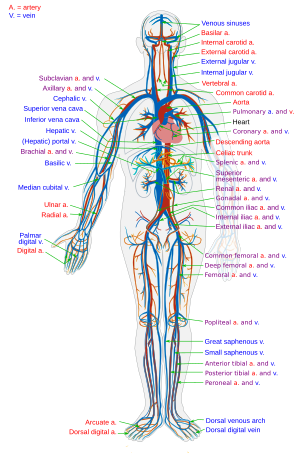Blood vessel

The blood vessels are the part of the circulatory system that transport blood throughout the body. There are three major types of blood vessels: the arteries, which carry the blood away from the heart, the capillaries, which enable the actual exchange of water and chemicals between the blood and the tissues; and the veins, which carry blood from the capillaries back towards the heart.
Anatomy
The arteries and veins have the same basic structure. There are three layers, from inside to outside while the capillaries have only one thick cell:
- Tunica intima (the thinnest layer): a single layer of simple squamous [[in arteries) be rich in vascular smooth muscle, which controls the caliber of the vessel.
- Tunica adventitia: entirely made of connective tissue. It also contains nerves that supply the muscular layer, as well as nutrient capillaries (vasa vasorum) in the larger blood vessels.
Capillaries consist of little more than a layer of endothelium and occasional connective tissue.
When blood vessels connect to form a region of diffuse vascular supply it is called an anastomosis (pl. anastomoses). Anastomoses provide critical alternative routes for blood to flow in case of blockages.
Laid end to end, all the blood vessels in an average human body would encircle the earth twice, a distance of approximately 100,000 kilometers.[1]
Types
There are various kinds of blood vessels:
- Arteries
- Aorta (the largest artery, carries blood out of the heart)
- Branches of the aorta, such as the carotid artery, the subclavian artery, the celiac trunk, the mesenteric arteries, the renal artery and the iliac artery.
- Arterioles
- Capillaries (the smallest blood vessels)
- Venules
- Veins
- Large collecting vessels, such as the subclavian vein, the jugular vein, the renal vein and the iliac vein.
- Venae cavae (the 2 largest veins, carry blood into the heart)
They are roughly grouped as arterial and venous, determined by whether the blood in it is flowing away from (arterial) or toward (venous) the heart. The term "arterial blood" is nevertheless used to indicate blood high in oxygen, although the pulmonary artery carries "venous blood" and blood flowing in the pulmonary vein is rich in oxygen. This is because they are carrying the blood to and from the lungs, respectively, to be oxygenated.
Physiology
Blood vessels do not actively engage in the transport of blood (they have no appreciable peristalsis), but arteries - and veins to a degree - can regulate their inner diameter by contraction of the muscular layer. This changes the blood flow to downstream organs, and is determined by the autonomic nervous system. Vasodilation and vasoconstriction are also used antagonistically as methods of thermoregulation.
Oxygen (bound to hemoglobin in red blood cells) is the most critical nutrient carried by the blood. In all arteries apart from the pulmonary artery, hemoglobin is highly saturated (95-100%) with oxygen. In all veins apart from the pulmonary vein, the hemoglobin is desaturated at about 75%. (The values are reversed in the pulmonary circulation.)
The blood pressure in blood vessels is traditionally expressed in millimetres of mercury (1 mmHg = 133 Pa). In the arterial system, this is usually around 120 mmHg systolic (high pressure wave due to contraction of the heart) and 80 mmHg diastolic (low pressure wave). In contrast, pressures in the venous system are constant and rarely exceed 10 mmHg.
Vasoconstriction is the constriction of blood vessels (narrowing, becoming smaller in cross-sectional area) by contracting the vascular smooth muscle in the vessel walls. It is regulated by vasoconstrictors (agents that cause vasoconstriction). These include paracrine factors (e.g. prostaglandins), a number of hormones (e.g. vasopressin and angiotensin) and neurotransmitters (e.g. epinephrine) from the nervous system.
Vasodilation is a similar process mediated by antagonistically acting mediators. The most prominent vasodilator is nitric oxide (termed endothelium-derived relaxing factor for this reason).
Permeability of the endothelium is pivotal in the release of nutrients to the tissue. It is also increased in inflammation in response to histamine, prostaglandins and interleukins, which leads to most of the symptoms of inflammation (swelling, redness and warmth).
Role in disease
Blood vessels play a role in virtually every medical condition. Cancer, for example, cannot progress unless the tumor causes angiogenesis (formation of new blood vessels) to supply the malignant cells' metabolic demand. Atherosclerosis, the formation of lipid lumps (atheromas) in the blood vessel wall, is the prime cause of cardiovascular disease, the main cause of death in the Western world.
Blood vessel permeability is increased in inflammation. Damage, due to trauma or spontaneously, may lead to haemorrhage due to mechanical damage to the vessel endothelium. In contrast, occlusion of the blood vessel by atherosclerotic plaque, by an embolised blood clot or a foreign body leads to downstream ischemia (insufficient blood supply) and possibly necrosis. Vessel occlusion tends to be a positive feedback system; an occluded vessel creates eddies in the normally laminar flow or plug flow blood currents. These eddies create abnormal fluid velocity gradients which push blood elements such as cholesterol or chylomicron bodies to the endothelium. These deposit onto the arterial walls which are already partially occluded and build upon the blockage.[2]
Vasculitis is inflammation of the vessel wall, due to autoimmune disease or infection.
References
This article needs additional citations for verification. (August 2008) |
